MEDICAL MASKS

-
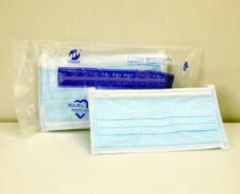 T-6571 DISPOSABLE MEDICAL MASK
T-6571 DISPOSABLE MEDICAL MASKDISPOSABLE MEDICAL MASK
Learn More
CERTIFICATE: CE
ITEM 001
QUANTITY: 10,000PCS-99,999PCS
ITEM 002
QUANTITY: 100,000-999,999PCS
ITEM 003
QUANTITY: ≥1MILLION -
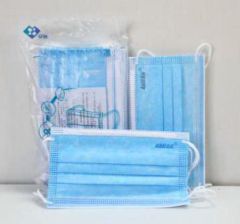 T-6570 STANDARD FOR CIVIL MASKS
T-6570 STANDARD FOR CIVIL MASKSSTANDARD FOR CIVIL MASKS
Learn More
CERTIFICATE: CE
ITEM 001
QUANTITY: 10,000PCS-99,999PCS
ITEM 002
QUANTITY: 100,000-999,999PCS
ITEM 003
QUANTITY: ≥1MILLION -
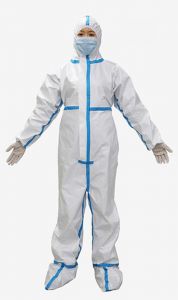 T-6566 DISPOSABLE MEDICAL STERILE PROTECTION SUIT (PP SUIT)
T-6566 DISPOSABLE MEDICAL STERILE PROTECTION SUIT (PP SUIT)DISPOSABLE MEDICAL STERILE PROTECTION SUIT (PP SUIT)
Learn More
IT'S MAINLY USED IN PLACES AS FOLLOW:
1) HOSPITALS;
2) OUTPATIENT CLINIC;
3) TESTING LABORATORIES;
4) AMBULANCES.
PROTECTIVE ISOLATION >99.9%
CERTIFICATE: CE/ISO
ITEM 001
QUANTITY: 1,000 PCS-9,999 PCS
ITEM 002
QUANTITY: 10,000PCS-99,999PCS
ITEM 003
QUANTITY: ≥100,000PCS -
 V-1819 KN95 MASKS AVAILABLE FOR SALE, CE CERTIFIED
V-1819 KN95 MASKS AVAILABLE FOR SALE, CE CERTIFIEDSTANDARD: GB2626-2006 KN95
0.3 MICRON PARTICULATE FILTERING > 95%
BUILT-IN ADJUSTABLE SOFT NOSE CLIP
4 LAYERS (4 PLY) IS AVAILABLE NOW
3 LAYERS (3 PLY) CAN ALSO BE MADE
ALL MASKS PASSED CE CERTIFICATIONQUANTITY:
Learn More
4 MASKS PER BAG
160 BAGS PER CARTON = 640 MASKS PER CARTON
350 CARTONS IN A 20 FOOT CONTAINER= 224,000 MASKS PER CONTAINER
WEIGHT AND DIMENSIONS OF ONE CARTON:
GROSS WEIGHT: 5.485 KG
DIMENSIONS: 520mm x 320mm x 480mm -
 D-2384 This is why you should get sterilizing equipment
D-2384 This is why you should get sterilizing equipmentD-2384 This is why you should get sterilizing equipment
Learn More -
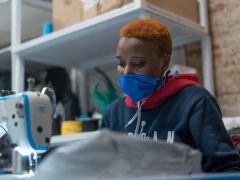 D-2388 What’s the Best Material for a Mask?
D-2388 What’s the Best Material for a Mask?Federal health officials have now recommended that we cover our faces with fabric during the coronavirus pandemic. But what material offers the most protection?
The Centers for Disease Control and Prevention has posted a no-sew mask pattern using a bandanna and a coffee filter as well as a video on making masks using rubber bands and folded fabrics found at home.
While a simple face covering can reduce the spread of coronavirus by blocking outgoing germs from coughs or sneezes of an infected person, experts say there is more variation in how much homemade masks might protect the wearer from incoming germs, depending on the fit and quality of the material used.
Scientists around the country have taken it upon themselves to identify everyday materials that do a better job of filtering microscopic particles. In recent tests, HEPA furnace filters scored well, as did vacuum cleaner bags, layers of 600-count pillowcases and fabric similar to flannel pajamas. Stacked coffee filters had medium scores. Scarves and bandanna material had the lowest scores, but still captured a small percentage of particles.
If you don’t have any of the materials that were tested, a simple light test can help you decide whether a fabric is a good candidate for a mask.
“Hold it up to a bright light,” said Dr. Scott Segal, chairman of anesthesiology at Wake Forest Baptist Health who recently studied homemade masks. “If light passes really easily through the fibers and you can almost see the fibers, it’s not a good fabric. If it’s a denser weave of thicker material and light doesn’t pass through it as much, that’s the material you want to use.”
Researchers say it’s important to remember that lab studies are conducted under perfect conditions with no leaks or gaps in the mask, but the test methods give us a way to compare materials. And while the degree of filtration for some homemade masks seems low, most of us — who are staying home and practicing social distancing in public — don’t need the high level of protection required for medical workers. More important, any face covering is better than none, especially if worn by a person who has the virus but doesn’t know it.
The biggest challenge of choosing a homemade mask material is to find a fabric that is dense enough to capture viral particles, but breathable enough that we can actually wear it. Some items being touted online promise high filtration scores, but the material would be unwearable.
Dressing Up for Work … at Home
Yang Wang, an assistant professor of environmental engineering at Missouri University of Science and Technology, worked with his graduate students to study various combinations of layered materials — including both air filters and fabric. “You need something that is efficient for removing particles, but you also need to breathe,” said Dr. Wang, who last fall won an international award for aerosol research.To test everyday materials, scientists are using methods similar to those used to test medical masks, which everybody agrees should be saved for medical workers who are exposed to high doses of virus from seeing infected patients. The best medical mask — called the N95 respirator — filters out at least 95 percent of particles as small as 0.3 microns. By comparison, a typical surgical mask — made using a rectangular piece of pleated fabric with elastic ear loops — has a filtration efficiency ranging from 60 to 80 percent.
Dr. Wang’s group tested two types of air filters. An allergy-reduction HVAC filter worked the best, capturing 89 percent of particles with one layer and 94 percent with two layers. A furnace filter captured 75 percent with two layers, but required six layers to achieve 95 percent. To find a filter similar to those tested, look for a minimum efficiency reporting value (MERV) rating of 12 or higher or a microparticle performance rating of 1900 or higher.
The problem with air filters is that they potentially could shed small fibers that would be risky to inhale. So if you want to use a filter, you need to sandwich the filter between two layers of cotton fabric. Dr. Wang said one of his grad students made his own mask by following the instructions in the C.D.C. video, but adding several layers of filter material inside a bandanna.
Dr. Wang’s group also found that when certain common fabrics were used, two layers offered far less protection than four layers. A 600 thread count pillow case captured just 22 percent of particles when doubled, but four layers captured nearly 60 percent. A thick woolen yarn scarf filtered 21 percent of particles in two layers, and 48.8 percent in four layers. A 100 percent cotton bandanna did the worst, capturing only 18.2 percent when doubled, and just 19.5 percent in four layers.
The group also tested Brew Rite and Natural Brew basket-style coffee filters, which, when stacked in three layers, showed 40 to 50 percent filtration efficiency — but they were less breathable than other options.
If you are lucky enough to know a quilter, ask them to make you a mask. Tests performed at the Wake Forest Institute for Regenerative Medicine in Winston-Salem, N.C., showed good results for homemade masks using quilting fabric. Dr. Segal, of Wake Forest Baptist Health, who led the study, noted that quilters tend to use high-quality, high-thread count cotton. The best homemade masks in his study were as good as surgical masks or slightly better, testing in the range of 70 to 79 percent filtration. Homemade masks that used flimsier fabric tested as low as 1 percent filtration, Dr. Segal said.
The best-performing designs were a mask constructed of two layers of high-quality, heavyweight “quilter’s cotton,” a two-layer mask made with thick batik fabric, and a double-layer mask with an inner layer of flannel and outer layer of cotton.
Bonnie Browning, executive show director for the American Quilter’s Society, said that quilters prefer tightly woven cottons and batik fabrics that stand up over time. Ms. Browning said most sewing machines can handle only two layers of fabric when making a pleated mask, but someone who wanted four layers of protection could wear two masks at a time.
Ms. Browning said she recently reached out to quilters on Facebook and heard from 71 people who have made a combined total of nearly 15,000 masks. “We quilters are very much in the thick of what’s going on with this,” said Ms. Browning, who lives in Paducah, Ky. “One thing most of us have is a stash of fabric.”
People who don’t sew could try a folded origami mask, created by Jiangmei Wu, assistant professor of interior design at Indiana University. Ms. Wu, who is known for her breathtaking folded artwork, said she began designing a folded mask out of a medical and building material called Tyvek, as well as vacuum bags, after her brother in Hong Kong, where mask wearing is common, suggested it. (DuPont, the maker of Tyvek, said in a statement that Tyvek is intended for medical apparel, not masks.) The folded mask pattern is free online, as is a video demonstrating the folding process. In tests at Missouri University and University of Virginia, scientists found that vacuum bags removed between 60 percent and 87 percent of particles. But some brands of vacuum bags may contain fiberglass or are harder to breathe through than other materials, and shouldn’t be used. Ms. Wu used a bag by EnviroCare Technologies, which has said it does not use fiberglass in its paper and synthetic cloth bags.
“I wanted to create an alternative for people who don’t sew,” said Ms. Wu, who said she is talking to various groups to find other materials that will be effective in a folded mask. “Given the shortage of all kinds of materials, even vacuum bags might run out.”
The scientists who conducted the tests used a standard of 0.3 microns because that is the measure used by the National Institute for Occupational Safety and Health for medical masks.
Linsey Marr, a Virginia Tech aerosol scientist and an expert in the transmission of viruses, said the certification method for respirators and HEPA filters focuses on 0.3 microns because particles around that size are the hardest to catch. While it seems counterintuitive, particles smaller than 0.1 microns are actually easier to catch because they have a lot of random motion that makes them bump into the filter fibers, she said.
“Even though coronavirus is around 0.1 microns, it floats around in a wide range of sizes, from around 0.2 to several hundred microns, because people shed the virus in respiratory fluid droplets that also contain lots of salts and proteins and other things,” said Dr. Marr. “Even if the water in the droplets fully evaporates, there’s still a lot of salt and proteins and other gunk that stays behind as solid or gel-like material. I think 0.3 microns is still useful for guidance because the minimum filtration efficiency will be somewhere around this size, and it’s what NIOSH uses.”
Learn More -
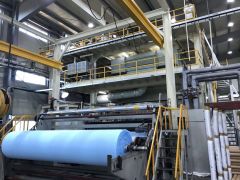 L-7129 NONWOVEN SMS PRODUCTION LINE, 1600mm, SPUNBONDED, MELT BLOWN
L-7129 NONWOVEN SMS PRODUCTION LINE, 1600mm, SPUNBONDED, MELT BLOWNPP CHIPS FOR MELTBLOWN: 1200 TO 2000
FABRIC WIDTH: 1600mm
2 SPINNING BEAMS FOR SPUNBOND & 1 FOR MELTBLOWN
BASIC WEIGHT: SMS 9 TO 80 GRAMS PER SQUARE METER
SS: 15 TO 100 GRAMS PER SQUARE METERPRODUCT:
SMS LAMINATED NONWOVEN FABRIC
SS SPUNBOND NONWOVEN FABRIC SS
M MELTBLOWN NONWOVEN FABRIC MTO MAKE HYGENIC FABRICS SUCH AS BABY DIAPERS, SANITARY NAPKINS, ADULT DIAPERS, MEDICAL OPERATION SUITS, OPERATION CAPS, OPERATIONS SHOES, MASKS, ETC.
CONSISTING OF:
3 X FEEDING SYSTEMS
AUTOMATIC VACUUM SUCTION FOR BOTH MAIN MATERIAL AND ADDITIVES
CAPACITY (SB + MB) 2 X 520 KGS/H, (SB) 2 X 200 KGS/HR
WITH THREE HOPPERS, THREE SUPPLIYING DEVICESSPUNBOND SYSTEM
2 X EXTRUDERS
DIAMETER: 150mm
CAPACITY: 450 KGS/HR
L/D 30:1
DRIVE POWER: 110 KW
HEATING POWER: 90 KW2 X RECYCLING SYSTEMS
DIAMETER: 105mm
CAPACITY: 100 KGS PER HOUR
L/D: 15:12 X MELT FILTERS
WORKING TEMPERATURE: UP TO 280 CELSIUS
FILTRATION CAPACITY: 520 KGS PER HOUR2 X METERING PUMPS
TYPE: GEAR PUMP
FLOW VOLUME: 250 ML/R
DESIGNING TEMPERATURE: 280 CELSIUS2 X MELT PIPELINES
WITH STATIC MIXER2 X MONOMER EXHAUSTER
INCLUDING BLOWER, CHILLER, PIPELINE, VALVE, INSULATION, ETC2 X SPINNING BEAMS
SINGLE COAT-HANGER MELT DISTRIBUTION
DESIGNING PRESSURE: 9MPA
WORKING TEMPERATURE: MAX 280 CELSIUS4 X SPINNERETS
HOLE DIAMETER: 0.45mm
L/D: 5:1
15,500 HOLESMELTBLOWN SYSTEM
1 X EXTRUDER
DIAMETER 120mm
CAPACITY: 280 KGS/HR
L/D: 30:1
DRIVE POWER: 75 KW
HEATING POWER: 80 KW1 X MELT FILTER
FILTRATION PRECISION: 20 TO 60 MICROMETERS
FILTRATION: 280 KGS PER HOUR1 X METERING PUMP
GEAR PUMP
MAX. FLOW VOLUME: 100ML/R
DESIGNED TEMPERATURE: 300 CELSIUS1 X MELT PIPELINE
WITH STATIC MIXER1 X SPINNING BEAM
INCLUDING STRETCHING CHANNEL, NOZZLE, ETC. WITH INSULATION MATERIAL
DESIGNED PRESSURE: 6 MPA2 X SPINNING DIE PACKS
COMPACT DIE PACKS
HOLE DIAMETER: 0.35mm
L/D: 12:1
# OF HOLES: 42HPI1 X SCREW BLOWER
INCLUDING MUFFLE, PRESSURE REDUCER VALVE, PIPELINE, ETC.
POWER: 200 KW1 X HOT AIR SYSTEM
FLOW VOLUME: 6000 CUBIC METERS PER HOUR
WORKING TEMP: MAX 350 CELSIUS
INCLUDING HEATER, STAINLESS STEEL PIPELINE, ETC.
POWER: 290 KW1 X OFF-LINE CONVEYOR
RANGE OF SPEED: 5 TO 100 METERS PER MINUTE1 X CONVEYOR
MECHANICAL SPEED: MAX 400 METERS PER MINUTE
BELT WIDTH AND PENETRATION
3800±10mm, 10000 CUBIC METERS PER H.M21 X CALENDAR
DOUBLE ROLLS HEATED BY OIL
PROCESS SPEED: 350 METERS PER MINUTE
EMBOSSING WIDTH: UP TO 2000mm
MAX LINEAR PRESSURE: 110 DAN/C
MAX. TEMP OF EMBOSSING ROLLER, 180 CELSIUS1 X WINDER
ONLINE CHANGING ROLL, ONLINE EDGE CUTTING, TENSION CONTROL
MAX. LINEAR SPEED: 350 METERS PER MINUTE
WIDTH: 1600mm
WIND DIAMETER: MAX 1500mm1 X SLITTER
MAX. LINE SPEED: 600 METERS PER MINUTE
MAX. WIND DIAMETER: 1200mm
MIN. SLITTING WIDE: 120mm
22 CIRCULAR BLADES1 X STEEL PLATFORM
1 X ELECTRICAL CONTROL SYSTEM
2 X OIL OVEN
1 X AIR CONDITIONING SYSTEM
1 X WATER COOLING SYSTEM
1 X CLEANING EQUIPMENTS FOR DIE PACK
1 X AUXILIARY PLATFORM
1 X AUXILIARY EQUIPMENTS
1 X LABORATORY TESTING DEVICE
Learn More -
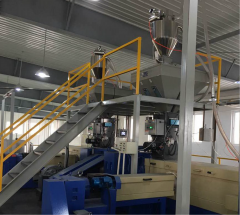 L-7134 PP NONWOVEN FABRIC PRODUCTION LINE, SPUNBONDED, MELT BLOWN
L-7134 PP NONWOVEN FABRIC PRODUCTION LINE, SPUNBONDED, MELT BLOWNEFFECTIVE WIDTH: 1600mm
DAILY OUTPUT: 10,000 KGS PER DAY
WEIGHT RANGE: 10 TO 150 GSM
FILAMENT DIAMETER: 1.6 TO 2.0 DENIER
SPEED: 350 TO 400 METERS PER MINUTE
RAW MATERIAL: POLYPROPYLENE (PP)
DIMENSIONS: 35,000 X 15,000 X 11,000mm
VOLTAGE: 380 VOLTS, 3 PHASECONSISTING OF:
SPUNBOND EQUIPMENT
PP VACUUM SUCTION MACHINE (2)
7800 TO 900 KGS PER HOUR
AIR CAPACITY: 300 CUBIC METERS PER HOUR
POWER: 7.5 KWMASTER BATCH DOSING UNIT (2)
ACCURACY: 0.01%EXTRUDER (2)
DIAMETER: 130mm
SINGLE SCREW (2)
HEATING SYSTEM: ELECTRICITY
MOTOR: 75 KWMELT FILTRATION MACHINE (2)
PIPE SIZE: 50mm
FILTER AREA: 3.5 SQUARE METERS
MELT FLOW: 650 KGS PER HOUR
DOUBLE FILTRATION CHAMBERMELTING PUMP (2)
40 RPM
FLOW CAPACITY: 400 KGS PER HOUR
POWER: 7.5 KWSPINNING BEAM (2)
DIMENSIONS: 1900 X 256mm
HANGER TYPE MELT DISTRIBUTION
HEATING SYSTEM: OIL
WORKING TEMPERATURE: 200 TO 260 CELSIUSSPINNERET (4)
HARDNESS: 30
SIZE: 1900mm LONG X 256mm WIDE
HOLE DIAMETER 0.45mm
HOLE QUANTITY: 6500 HOLE PER METERQUENCHING UNIT (2)
WORKING TEMP: 20 CELSIUS
AIR FLOW CAPACITY: 12,000 CUBIC METERS/H
AIR PRESSURE: 6500
FILTER SIZE: 80#FILAMENT DRAFT UNITS (2)
AIR PRESSURE: 5020PA
AIR FLOW CAPACITY: 12,000 CUBIC METERS/H
INSIDE TEMP: 10 TO 25 CELSIUS
FILAMENT FINENESS: 1.6 TO 2.0 DENIERMELT BLOWN EQUIPMENT
VACUUM SUCTION MACHINE (2)
LOAD CAPACITY: 700 TO 900 KGS PER HOUR
AIR CAPACITY: 300 CUBIC METERS/H
POWER: 7.5 KWMASTER BATCH DOSING UNIT (2)
4 HOPPERS
200 KGS HOPPER LOADEXTRUDER
DIAMETER: 105mm
SINGLE SCREW
MOTOR: 18.5 KWMELT FILTER
DOUBLE CYLINDER
HYDRAULIC
MELT FLOW CAPACITY: 450 KGS/HR
FILTER SIZE: 150mm DIAMETER
ELECTRIC HEATINGMELTING PUMP
SPEED: 40 RPM
MELT FLOW CAPACITY: 450 KGS PER HOUR
POWER: 7.5 KWMELT BLOWN DIE SPINNARET
SPINNERET HOLE SIZE: 0.32 TO 0.35mm
HOLE DISTANCE: 40 TO 42 PER INCH
FABRIC WEIGHT: 2 TO 200 GSMHIGH PRESSURE AIR BLOWER
AIR FLOW CAPACITY: 70 TO 100 CUBIC METERS PER MINUTE
AIR PRESSURE: 100 KPA
POWER: 200 KWWEB FORMING MACHINE
SPEED: 100 METERS PER MINUTEELECTRIC TREATMENT
VOLTAGE: 220 VOLTS, 50 Hz
INPUT CURRENT: 3A
OUTPUT VOLTAGE: 60 KV
TREAT WEB WIDTH: 1.6 METERSHOT AIR HEATING MACHINE
WORKING TEMP: 350 CELSIUS
PRESSURE: 0.8 KPA
HEATING: ELECTRIC
POWER: 200 KWTHERMAL CALENDER
PROCESSING SPEED: 400 METERS PER MINUTE
ROLLER SIZE: 2000mm LONG, 520mm DIAMETER
EMBOSSING ROLLER: 1
LINEAR PRESSURE: 30 TO 125 N/mm
HEATING SYSTEM: OILHYDROPHILIC MACHINE
SPEED: 400 METERS PER MINUTE
FEEDING SYSTEM: DOUBLE KISSING ROLLER
KISS ROLLER DIAMETER: 215mm
LIQUID TANK: 200 KGS WITH HEAT/WARM AND MIXDRYING SYSTEM:
INFRARED + HOT AIR
DRIVE ROLL SIZE: 150mm
HEATING EQUIPMENT: QUARTZ HEATER, HOT AIR BLOWER, EXHAUST AIR BLOWERINSPECTION MACHINE
EFFECTIVE WIDTH: 1600mm
INSPECTION SPEED: 400 METERS PER MINUTE
INSPECT GSM: 10 TO 40 GSMAUTOMATIC WINDING MACHINE
SPEED: 400 METERS PER MINUTE
ROLLER DIAMETER: 2000mm
ROLLER EXCHANGE SYSTEM: AUTOMATIC
FABRIC INSPECTOR: ONLINE
POWER: 15 KWHIGH SPEED SLITTING MACHINE
PROCESS SPEED: 800 METERS PER MIN
ROLL DIAMETER: MAX 1500mm
SLITTING WIDTH: 80mm
PAPER TUBE SIZE: 76mm DIAMETER
AUTO TENSILE CONTROL: AVAILABLE ONLINE
METER COUNTING: AVAILABLE ONLINEOIL HEATER (4)
HEATING POWER: 60 KW
MOTOR POWER: 7.5 KW
OIL PUMP FLOW: 30 CUBIC METERS PER SECOND
PRESSURE: 0.4 KPAWATER CHILLER
DRIVE SYSTEM: SCREW
COOLING CAPACITY: 300,000 CALORIES
TEMP: 0 TO 20 CELSIUS
POWER: 110 KWAIR BLOWER
SPEED: 1450 RPM
AIR BLOW CAPACITY: 12,000 CUBIC METERS PER HOUR
PRESSURE: 5200 PA
POWER: 30 KW x 3, 45 KW x 1AIR COMPRESSOR
DRIVE SYSTEM: SCREW
PRESSURE: 0.8 KPA
POWER: 15 KWHEATING SYSTEM: ELECTRIC
TEMP: 350 CELSIUS
HEATING TIME: 6 TO 8 HOURS
POWER: 4 KWULTRASONIC CLEANING MACHINE
3mm THICK
SIZE: 2000 X 500mm
FREQUENCY VIBRATION: 100 KHZ
TEMP: 40 CELSIUSELECTRONIC PANEL BOARD
PLATFORM
Learn More -
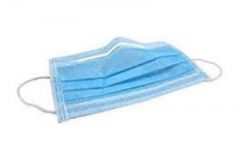 J-2795 DISPOSABLE FACE MASKS, 3-PLY SPUNBOND-MELTBLOWN-SPUNBOND, 50 PIECES PER BOX
J-2795 DISPOSABLE FACE MASKS, 3-PLY SPUNBOND-MELTBLOWN-SPUNBOND, 50 PIECES PER BOXDISPOSABLE FACE MASKS
MATERIAL: 3-PLY (100% VIRGIN FIBER)
1ST LAYER NONWOVEN PP SPUNBOND
2ND LAYER NONWOVEN PP MELTBLOWN
3RD LAYER NONWOVEN PP SPUNBOND
MASK SIZE: 175mm x 95mm (ADULT SIZE)
WEIGHT: 2.9 TO 3.2 GRAMS EACH
50 PIECES PER BOX / 40 BOXES PER CARTON
• LOW BREATHING RESISTANCE
• SOFT LINING, NON-IRRITATING TO SKIN
• FIBERGLASS FREE AND LATEX FREE
• WITH ADJUSTABLE NOSE BRIDGE SUPPORT PIECE
• WITH ELASTIC EAR LOOPSQUANTITY: 50,000 PIECES OF FRESH STOCK CURRENTLY AVAILABLE
Learn More -
 V-1817 SEMI-AUTOMATIC NOSE CLIP WELDING MACHINE
V-1817 SEMI-AUTOMATIC NOSE CLIP WELDING MACHINESEMI-AUTOMATIC NOSE CLIP WELDING MACHINE FOR NOSE CLIP WELDING FOR DUST MASK RESPIRATORS, IT’S EASY TO OPERATE, FIRM WELDING EFFECT. THIS MACHINE INCORPORATES CONSTANT TEMPERATURE WELDING, WHICH IS NOT HARMFUL TO THE FABRIC, IT’S THE IDEAL MACHINE FOR DUST MASK RESPIRATOR MANUFACTURING.
FEATURES:
1. THIS MACHINE IS EASY TO OPERATE; THE GLUED ALUMINUM NOSE CLIP IS MOVED BY PNEUMATIC THEN WELDED ONTO THE MASK.
2. IT’S HIGH PRECISION AND THE NOSE CLIP WELD IS FIRM.
3. WELDING WITH CONSTANT TEMPERATURE WHICH IS NOT HARMFUL TO THE FABRIC.
ITEM NAME
TECHNICAL PARAMTER
QTY
REMARK
SPECIFICATION
1200mm X 650mm X 1000mm
1
HONGDA
WEIGHT
50KG
EFFICIENCY
8 TO 15PCS/MIN
VOLTAGE
220V/380V
AIR PRESSURE
5KG/CM²
FREQUENCY
20KHZ
POWER
600W
MOLD SERVO MOTOR
SGM7G-09AFC61 4.4KW
1
YASKAWA
ULTRASONIC POWER SERVO MOTOR
SGM7G-13AFC61 1.3KW
2
YASKAWA
MATERIAL PULLING SERVO MOTOR
SGM7G-09AFC61 0.85KW
2
YASKAWA
MATERIAL FEEDING/CORRECTING/INDENTATION MOTOR
130BYG-350A
4
SONGYANG
POUCHING MOTOR
110BYG-350B
4
SONGYANG
110 STEPPER MOTOR
110BYG-350A
10
SONGYANG
UP AND LOWER MOTOR
90BYG-350A
2
SONGYANG
STEPPER MOTOR 56
SY57STH56-2004A
8
SONGYANG
DIRECT CURRENT MOTOR
0.4KW
2
DIRECT CURRENT MOTOR
0.6KW
1
ASYNCHRONOUS THREE-PHASE MOTOR
90S-6
1
0.75KW
FREQUENCY CONVERTER
AVF200-0152
1
1.5KW
MAIN PNEUMATIC COMPONENTS: AIRTAC(TAIWAN); MAIN ELECTRICAL COMPONENTS: PANASONIC(JAPAN), SICK(GERMANY), DONLIM(CHINA&JAPAN), ETC.
EMAIL US FOR PRICE & PICTURES
INCLUDE OUR REFERENCE NUMBER
Learn More
